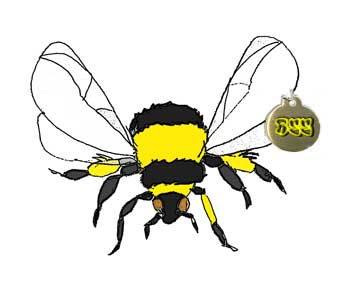Pesticides Slow Down Bumblebee Pollen Gathering
Plus Pyrethroid Pesticides Shrink Bumblebees!
By Susan Fluegel, PHD
Take home message: Bumblebees exposed to low levels of a neonicotinoid insecticide collect less pollen than bees not exposed to the insecticide. Since bees use pollen to feed their young this can cause the bumblebee colony to fail.
Pollen is a vital source of protein for bumblebees. Bees need pollen to feed their babies. Neonicotinoid toxins found in insecticides such as imidacloprid prevent bees from gathering enough pollen to feed their growing little ones. 
Feltham et al. (2014) sprayed a field with low doses of imidacloprid. The concentration of the pesticide was similar to that found in normal sprayed fields. Each test bumblebee wore a tiny electronic tag so their movements could be tracked. In addition, each bee was weighed on its way in or out of the nest (I wonder if the intern got this job).
Bees that were exposed to the neonicotinoid pesticide didn't feel up to working. They carried back less pollen on fewer trips. These so called worker bees brought back pollen from only 40% of trips and when they brought back pollen, it was 31% less than pesticide free bumbles. They also spent much more time cruising the internet, mindlessly tweeting "OMG just saw the tackiest flower! Who combines orange with purple anyway? Let me take a selfie." #lazybee and updating their FaceBook pages.
Bumblebees not exposed to pesticides carried pollen back from 63% of trips and spent their free time delivering pollen to hungry larvae. In total, bumblebee nests exposed to the insecticide collected 57% less pollen. That is less than half the pollen collected by unexposed bumblebees.
Currently there is a two year temporary European Union ban on three neonicotinoid pesticides.
Pyrethroid Pesticides Shrink Bumblebees!
Bumblebees exposed to pyrethroid pesticides over a 4 month period grew smaller each generation. Worker bees exposed to the pesticide grew less and were significantly smaller than unexposed bees (Baron et al. 2014). Bees were exposed to pesticide at the concentration recommended for spraying the oilseed canola (rape).
Research has shown that larger bumblebees are more effective at foraging for food. While miniature bees might be cute they cannot carry as much pollen and nectar back to the hive to feed their young. This can endanger the health of the whole hive.
Do you want to know more about the plight of the bees? Check out these great free resources:
Honey Bees and Pesticides: State of the Science. By Heather Pilatic, PHD. 2012 (22 page PDF report on the factors behind colony collapse disorder that you can read or download for free at PAN North America)
A Review of Research into the Effects of Neonicotinoid Insecticides on Bees, with Recommendations for Action By Jennifer Hopwood, Mace Vaughan, Matthew Shepherd, David Biddinger, Eric Mader, Scott Hoffman Black, and Celeste Mazzacano. 2012. (44 page PDF copy available or the 2 page summary at the Xerces Society that you can download or read for free)
What About Birds?
Neonicotinoid pesticides kill more than bees, they are also dangerous for songbirds and aquatic systems. A report commissioned by American Bird Conservancy (ABC) stated that one corn kernel or wheat seed treated with the neonicotinoid insecticide Imidacloprid can kill an average sized songbird. A tenth of that amount can affect a songbird's reproductive ability. For more information see ABC's report, "The Impact of the Nation's Most Widely Used Pesticide on Birds" American Bird Conservatory March 2013 by Dr. Pierre Mineau and Cynthia Palmer.
References:
- Baron GL, Raine NE and Brown MJF. Impact of chronic exposure to a pyrethroid pesticide on bumblebees and interactions with a trypanosome parasite. J. Applied Ecology. 2014 DOI: 10.1111/1365-2664.12205 (full text)
- Blacquière T1, Smagghe G, van Gestel CA, Mommaerts V. Neonicotinoids in bees: a review on concentrations, side-effects and risk assessment. Ecotoxicology. 2012;21:973-92. Pubmed. doi: 10.1007/s10646-012-0863-x (full text)
- Feltham H, Park K, Goulson D. Field realistic doses of pesticide imidacloprid reduce bumblebee pollen foraging efficiency. Ecotoxicology. 2014 Jan 22. [Epub ahead of print] Pubmed.
